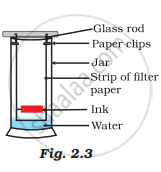Advertisements
Advertisements
Question
Calculate the molarity of a solution of ethanol in water in which the mole fraction of ethanol is 0.040 (assume the density of water to be one).
Solution
Mole fraction of C2H5OH `=("Number of moles of ""C"_2"H"_5"OH")/"Number of moles of solution"`
`0.040="n"_("C"_2"H"_5"OH")/("n"_("C"_2"H"_5"OH")+"n"_("H"_2"O"))` .......(1)
Number of moles present in 1 L water:-
`"n"_("H"_2"O") = (1000 " g")/(18 " g"" mol"^-1)`
`"n"_("H"_2"O") = 55.55 " mol"`
Substituting the value of `"n"_("H"_2"O")` in equation (1),
`"n"_("C"_2"H"_5"OH")/("n"_("C"_2"H"_5"OH")+55.55)=0.040`
`"n"_("C"_2"H"_5"OH") = 0.040 "n"_("C"_2"H"_5"OH") + (0.040)(55.55)`
`0.96" n"_("C"_2"H"_5"OH") = 2.222 " mol"`
`"n"_("C"_2"H"_5"OH") = 2.222/0.96" mol"`
`"n"_("C"_2"H"_5"OH") = 2.314" mol"`
∴ Molarity of solution `=(2.314" mol")/(1 "L")`
= 2.314 M
APPEARS IN
RELATED QUESTIONS
To make a saturated solution, 36 g of sodium chloride is dissolved in 100 g of water at 293 K. Find its concentration at this temperature.
Calculate the amount of carbon dioxide that could be produced when 2 moles of carbon are burnt in 16 g of dioxygen.
Dinitrogen and dihydrogen react with each other to produce ammonia according to the following chemical equation:
\[\ce{N2 (g) + 3H2 (g) → 2NH3 (g)}\]
(i) Calculate the mass of ammonia produced if 2.00 × 103 g dinitrogen reacts with 1.00 × 103 g of dihydrogen.
(ii) Will any of the two reactants remain unreacted?
(iii) If yes, which one and what would be its mass?
Explain the term molality
Solve the following problem:
Write the following number in ordinary decimal form:
43.71 × 10−4
Solve the following problem:
Write the following number in ordinary decimal form:
14.3 × 10−2
Solve the following problem:
Perform the following calculation. Round off your answer to two digits.
`1/(3.40xx10^24)`
Perform each of the following calculations. Round off your answers to three digits.
(3.26104) (1.54106)
Solve the following problem:
Perform the following calculation. Round off your answer to three digits.
`((9.28xx10^9)(9.9xx10^-7))/((511)(2.98xx10^-6))`
Solve the following problem:
A 1.000 mL sample of acetone, a common solvent used as a paint remover, was placed in a small bottle whose mass was known to be 38.0015 g.
The following values were obtained when the acetone - filled bottle was weighed: 38.7798 g, 38.7795 g and 38.7801 g. How would you characterise the precision and accuracy of these measurements if the actual mass of the acetone was 0.7791 g?
What are the favourable qualities given to gold when it is alloyed with copper or silver for the purpose of making ornaments?
When light is passed through water containing a few drops of milk, it shows a bluish tinge. This is due to the ______ of light by milk and the phenomenon is called ______. This indicates that milk is a ______ solution.
Non-metals are usually poor conductors of heat and electricity. They are non-lustrous, non-sonorous, non-malleable and are coloured.
Name a lustrous non-metal.
A child wanted to separate the mixture of dyes constituting a sample of ink. He marked a line by the ink on the filter paper and placed the filter paper in a glass containing water as shown in Fig.2.3. The filter paper was removed when the water moved near the top of the filter paper.
(i) What would you expect to see, if the ink contains three different coloured components?
(ii) Name the technique used by the child.
(iii) Suggest one more application of this technique.

If 500 mL of a 5 M solution is diluted to 1500 mL, what will be the molarity of the solution obtained?
If the concentration of glucose \[\ce{(C6H12O6)}\] in blood is 0.9 g L–1, what will be the molarity of glucose in blood?
Which of the following terms are unitless?
(i) Molality
(ii) Molarity
(iii) Mole fraction
(iv) Mass percent
If 4 g of \[\ce{NaOH}\] dissolves in 36 g of \[\ce{H2O}\], calculate the mole fraction of each component in the solution. Also, determine the molarity of solution (specific gravity of solution is 1g mL–1).
